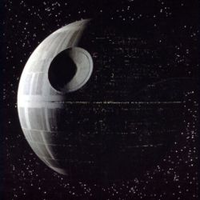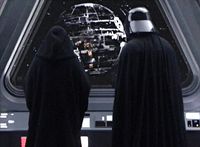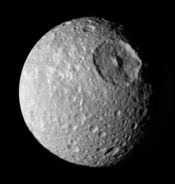Death Star

The Death Star is a fictional moon-sized space station and superweapon appearing in the Star Wars movies and expanded universe. It is capable of destroying a planet with a single destructive beam emitted from the large indentation on its surface. In the films, the first Death Star is featured in Star Wars Episode III: Revenge of The Sith being constructed and in Star Wars Episode IV: A New Hope which at that time is fully constructed, and a second Death Star is under construction in Star Wars Episode VI: Return of the Jedi. In addition, the schematics for the device were shown in Star Wars Episode II: Attack of the Clones given to Count Dooku.
Contents |
Origin and design
Although particular details, such as the superlaser's location, shifted between different concept models during A New Hope's production, the notion of the Death Star being a large, spherical space station was consistent in all of them.[1] Portraying an incomplete, yet powerful space station posed a problem for Industrial Light & Magic's modelmakers for Return of the Jedi.[2] Only the front side of the 137-centimeter model was completed, and the image was flipped horizontally for the final film.[2] Both Death Stars were depicted by a combination of complete and sectional models and matte paintings.[1][2]
Depiction

Films
The original Death Star first appears in A New Hope. Commanded by Grand Moff Tarkin (Peter Cushing), it is the Galactic Empire's "ultimate weapon", a space station capable of destroying a planet in a single attack. The film opens with Leia Organa (Carrie Fisher) transporting the station's schematics to the Rebel Alliance to aid them in destroying the Death Star. Tarkin orders the Death Star to destroy Leia's home world of Alderaan in an attempt to pressure her to betray the Rebels. In the film's climactic battle, Luke Skywalker (Mark Hamill) uses his power in the Force to help him destroy the station.
In Return of the Jedi, set four years later, the Empire is building a new Death Star; it is half-finished throughout the film. Emperor Palpatine (Ian McDiarmid) and Darth Vader (David Prowse/James Earl Jones) send the Rebels false information that the station's weapons systems are not operational in order to lure them into a trap, and bring Skywalker on board to tempt him over to the dark side of the Force. In the film's climax, Vader kills Palpatine on board, and is mortally wounded in the process. Skywalker escapes with Vader's body moments before the Rebels destroy the station.
The first Death Star also appears in the Star Wars prequel trilogy: its schematics are visible in Star Wars Episode II: Attack of the Clones, and the end of Star Wars Episode III: Revenge of the Sith shows the Death Star early in its construction.
Expanded Universe

The Death Stars appear throughout the Star Wars Expanded Universe. The first Death Star's construction is the subject of Michael Reaves and Steve Perry's novel Death Star. In LucasArts' Star Wars: Battlefront II, the player participates in a mission to secure crystals used in the Death Star's superlaser. The first Death Star under construction acts as the final stage in the video game, The Force Unleashed. Kevin J. Anderson's Jedi Academy trilogy introduces the Maw Cluster of black holes that protect a laboratory where the Death Star prototype was built (consisting of the super structure, power core, and Super Laser.) National Public Radio's A New Hope adaptation portrays Leia (Ann Sachs) and Bail Organa's (Stephen Elliott) discovery of the Death Star's existence and Leia's mission to steal the space station's schematics. The first level of LucasArts' Dark Forces gives the player a supporting role in Leia's mission, while a mission in Battlefront II tasks the player with acting as a stormtrooper or Darth Vader in an attempt to recover the plans and capture Leia. Steve Perry's novel Shadows of the Empire describes a mission that leads to the Rebels learning of the second Death Star's existence, and that mission is playable in LucasArts' X-Wing Alliance combat flight simulator. Numerous LucasArts titles recreate the movies' attacks on the Death Stars, and the Death Star itself is a controllable weapon in the Rebellion and Empire at War strategy game. A Death Star variation appears in Kevin J. Anderson's novel Darksaber.
The first Death Star is depicted in various sources of having a crew of 265,675, as well as 52,276 gunners, 607,360 troops, 30,984 stormtroopers, 42,782 ship support staff, and 180,216 pilots and support crew.[3] Its hangars contain assault shuttles, blastboats, Strike cruisers, land vehicles, support ships, and 7,293 TIE fighters.[4] It is also protected by 10,000 turbolaser batteries, 2,600 ion cannons, and at least 768 tractor beam projectors.[4] Various sources state the first Death Star has a diameter between 120 and 160 kilometers.[3][5] There is a broader range of figures for the second Death Star's diameter, ranging from 160 to 900 kilometers.[6][7]
Other uses of the term
Astronomers sometimes use the term "Death Star" to describe Nemesis, a hypothetical star postulated in 1984 to be responsible for gravitationally forcing comets and asteroids from the Oort cloud toward Earth.[8]
Enron labeled one of the false companies used in its fraudulent manipulation of the California power grid "Death Star".[9]
Cultural impact
The Death Star is one of the better-known concepts from the Star Wars universe and is widely recognizable outside of that context.
In 1981, following the Voyager spacecraft's flight past Saturn, scientists noticed a resemblance between one of the planet's moons, Mimas, and the Death Star.[10] While the moon was discovered in 1789, the first close-up photographs of the satellite detailing the large crater in its northern hemisphere were obtained several years after the Death Star was fabricated for the Star Wars movies. As such, the resemblance of the Death Star to Mimas is purely coincidental.
The video games Sonic the Hedgehog 2, Sonic the Hedgehog 3, and Sonic & Knuckles contain plotlines centered around the "Death Egg", a space station resembling the Death Star, though altered to feature the face of series villain Doctor Eggman. The Death Egg is built as a destructive superweapon; the story revolves around destroying this object. A similar superweapon, the Space Colony ARK (with the Eclipse Cannon), appears in Sonic Adventure 2 and Shadow the Hedgehog.
The Death Star placed ninth in a 2008 20th Century Fox poll of the most popular movie weapons.[11]
In the US, networks that compete with Fox refer to American Idol as the Death Star due to its destructive effects on their schedules and ratings.[12][13]
The UC Davis Social Sciences and Humanities Building, designed by Antoine Predock, is known as "The Death Star" to students due to its spaceship-like façade.[14]
In Canada, the term "death stars" was used to describe U.S. Direct Broadcast Satellites capable of broadcasting signals into Canada that were not regulated by the Canadian Radio-television and Telecommunications Commission.[15]
The Creative Artists Agency's headquarters has been nicknamed the "Death Star" by the entertainment media.[16]
RAF Mount Pleasant in the Falkland Islands is nicknamed "Death Star" due to its confusing layout.
Merchandise
Kenner and AMT created a playset and a model, respectively, of the first Death Star.[17][18] In 2005 and 2008, Lego released models of Death Star II and Death Star I, respectively.[19][20] Palitoy created a heavy card version of the Death Star as a playset for the vintage range of action figures in 1979 in the UK, Australia and Canada. Both Death Stars are part of different Micro Machines three-packs.[21][22] The Death Stars and locations in them are cards in Decipher, Inc.'s and Wizards of the Coast's Star Wars Customizable Card Game and Star Wars Trading Card Game, respectively.[23] Hasbro released a Death Star model that transforms into a Darth Vader mech.[24] Estes Industries released a flying model rocket version.[25]
See also
- List of Star Wars superweapons
References
- ↑ 1.0 1.1 "Death Star (Behind the Scenes)". Star Wars Databank. Lucasfilm. http://www.starwars.com/databank/location/deathstar/?id=bts. Retrieved 2007-09-08.
- ↑ 2.0 2.1 2.2 "Death Star II (Behind the Scenes)". Star Wars Databank. Lucasfilm. http://www.starwars.com/databank/location/deathstarii/?id=bts. Retrieved 2007-09-08.
- ↑ 3.0 3.1 "Death Star (Expanded Universe)". Star Wars Databank. Lucasfilm. http://www.starwars.com/databank/location/deathstar/?id=eu. Retrieved 2007-08-09.
- ↑ 4.0 4.1 Slavicsek, Bill (1991-06-01). Death Star Technical Companion. West End Games.
- ↑ Reynolds, David (1998-10-05). Incredible Cross-Sections of Star Wars, Episodes IV, V & VI: The Ultimate Guide to Star Wars Vehicles and Spacecraft. DK Children. ISBN 0789434806.
- ↑ "Death Star II (Expanded Universe)". Star Wars Databank. Lucasfilm. http://www.starwars.com/databank/location/deathstarii/?id=eu. Retrieved 2007-09-08.
- ↑ Inside the Worlds of Star Wars, Episodes IV, V, & VI: The Complete Guide to the Incredible Locations. DK Children. 2004-08-16. ISBN 0756603072.
- ↑ Britt, Robert Roy (2001-04-03). "Nemesis: Does the Sun Have a 'Companion'?". Space.com. http://www.space.com/scienceastronomy/solarsystem/nemesis_010320-1.html. Retrieved 2008-08-21. "Any one of them could be the Death Star, as Nemesis has come to be called by some."
- ↑ Kranhold, Kathryn; Bryan Lee and Mitchel Benson (2002-05-07). "New Documents Show Enron Traders Manipulated California Energy Costs". Free Preview. The Wall Street Journal. http://online.wsj.com/article/SB1020718637382274400.html. Retrieved 2008-08-21.
- ↑ Young (2005-02-11). "Saturn's moon is Death Star's twin". New Scientistfirst=Kelly. http://www.newscientist.com/article.ns?id=dn6999. Retrieved 2008-08-21. "Saturn's diminutive moon, Mimas, poses as the Death Star - the planet-destroying space station from the movie Star Wars - in an image recently captured by NASA's Cassini spacecraft."
- ↑ Sophie Borland (2008-01-21). "Lightsabre wins the battle of movie weapons". The Daily Telegraph. http://www.telegraph.co.uk/news/main.jhtml?xml=/news/2008/01/21/nweapon121.xml. Retrieved 2008-01-26.
- ↑ Carter, Bill (2007-02-20). "For Fox’s Rivals, ‘American Idol’ Remains a ‘Schoolyard Bully’". The New York Times. http://www.nytimes.com/2007/02/20/arts/television/20idol.html. Retrieved 2008-03-13. "If any of Fox’s rivals had hopes that this year might signal some hint that the monster — NBC favors the term Death Star — would finally betray some sign of weakness, those hopes were dispelled in just a week."
- ↑ Bauder, David (2007-01-30). "'Idol' Attracts More Than 32M Viewers". The Associated Press. http://www.washingtonpost.com/wp-dyn/content/article/2007/01/30/AR2007013001098.html?nav=rss_artsandliving/entertainmentnews. Retrieved 2008-03-13. "Rival television executives not-so-fondly refer to Fox's American Idol as the "death star.""
- ↑ Harrison, Mason (2007). "The Love-Hate Building". Free Preview. The Wall Street Journal. http://ucdavismagazine.ucdavis.edu/issues/win07/campus_views.html. Retrieved 2009-06-01.
- ↑ Hoskins, Colin; Stuart McFadyen and Adam Finn (1994). "The Environment in which Cultural Industries Operate and Some Implications". Canadian Journal of Communication. http://www.cjc-online.ca/viewarticle.php?id=247&layout=html. Retrieved 2007-09-09. "Their strategy has been to paint a doom-and-gloom scenario with respect to the effect of expected U.S. DBS services, dubbing the satellites "death stars.""
- ↑ "Agents: A Big Week for CAA!". Defamer. Gawker Media. 2007-03-16. http://defamer.com/hollywood/agents/a-big-week-for-caa-244882.php. Retrieved 2007-09-09. "We're told that most of the agency is away on a weekend retreat in Ojai, leaving the Death Star defended solely by some call-rolling drones"
- ↑ "Death Star Space Station". SirStevesGuide.com Photo Gallery. Steve Sansweet. http://photos.sirstevesguide.com/showphoto.php?photo=8976&cat=3383. Retrieved 2007-09-09.
- ↑ "Death Star". SirStevesGuide.com Photo Gallery. Steve Sansweet. http://photos.sirstevesguide.com/showphoto.php?photo=7909&cat=2967. Retrieved 2007-09-09.
- ↑ "LEGO Death Star". Star Wars Cargo Bay. Lucasfilm. http://cargobay.starwars.com/webapps/cargobay/item-detail/18167. Retrieved 2007-09-09.
- ↑ "3,800-Piece Death Star Diorama Is Coolest Star Wars Lego Ever". Gizmodo. 2008-06-19. http://gizmodo.com/5018137/3800+piece-death-star-diorama-is-coolest-star-wars-lego-ever. Retrieved 2008-06-20.
- ↑ "#X: T-16 Skyhopper, Lars Family Landspeeder, Death Star II (1996)". Star Wars Cargo Bay. Lucasfilm. http://cargobay.starwars.com/webapps/cargobay/item-detail/11803. Retrieved 2007-09-09.
- ↑ "#XIV: Landing Craft, Death Star, Speeder Swoop (1998)". Star Wars Cargo Bay. Lucasfilm. http://cargobay.starwars.com/webapps/cargobay/item-detail/11799. Retrieved 2007-09-09.
- ↑ "Star Wars Customizable Card Game Complete Card List" (PDF). Decipher, Inc.. 2001-08-23. http://www.decipher.com/starwars/cardlists/swallcards.pdf. Retrieved 2007-08-23.
- ↑ "Star Wars TRANSFORMERS Darth Vader Death Star". Hasbro. http://www.hasbro.com/default.cfm?page=browse&product_id=19856. Retrieved 2008-01-05.
- ↑ "ESTES INDUSTRIES INC. Model Rockets and Engines". http://www.udisco.com/hobbies/inv/ESTES.HTM. Retrieved 2008-08-21.
External links
- Death Star in the Star Wars Databank
- Death Star II in the Star Wars Databank
- Death Star on Wookieepedia: a Star Wars Wiki
|
||||||||||||||
